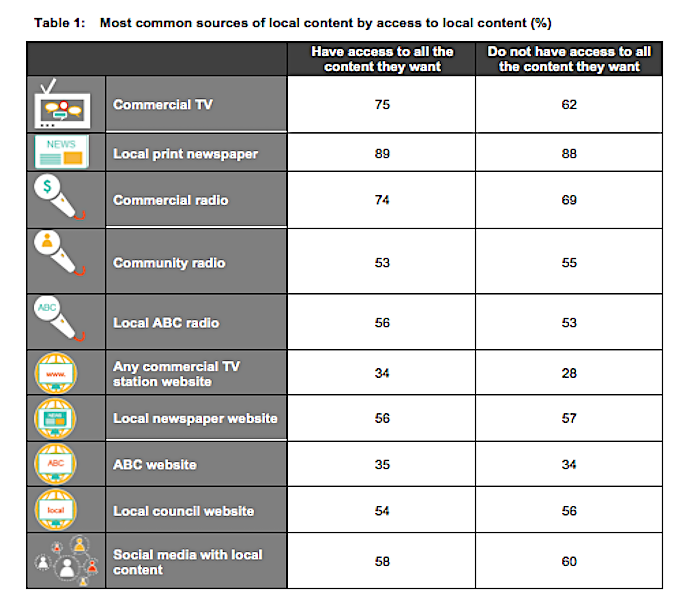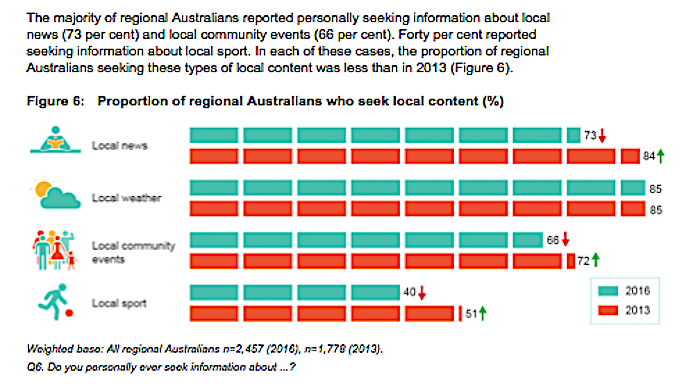86% of regional Australians say local news is important to them, according to research released last week at the ACMA Content Conversation in Sydney.
87% of regional Australians are satisfied with the overall quality of local news available in their local area and 78% of regional Australians have access to all the local content they would like.
The communications and media landscape in Australia has changed rapidly over the past 10 to 15 years, with the report outlining the following major changes:
New and emerging technologies — for example, LTE-broadcast and 5G mobile network technology are likely to increase connectivity and further influence data and content consumption.
Greater variety of content platforms and devices — there has been increased content uptake on a variety of new platforms and devices, including websites, apps, social media, subscription video on demand (SVOD), live streaming services and catch-up TV services available online.
Media convergence — the convergence of media platforms and services continues to blur the distinctions between broadcasters and other media across the supply chain for content creation, aggregation and distribution, changing how audiences consume media.
Changing consumer behaviour and preferences — consumers are watching more video content online, using mobile more than desktop platforms to access the internet and increasing the volume of data they download.
General decline in free-to-air TV audiences — there has been a slow decline in the average time spent watching free-to-air TV. Broadcast TV remains the main source of news for adult Australians, with 36 per cent accessing news via TV.
Changes in metropolitan/regional TV network affiliations — in mid-2016, a number of metropolitan TV networks changed or renegotiated affiliation arrangements with their regional TV network counterparts. This is likely to affect the availability of local content and local news in regional Australia.
ACMA’s Jenny Briggs told conference delegates there are 5 key points emerging from ACMA’s recent research into local content in regional Australia.
2. Some local content providers are collaborating to provide the same local news across their respective platforms to extend their audience reach.
For example Community radio services, such as Riverland Life FM (Renmark) and Hot FM (Mildura) partner with local journalists from the Taylor Group of Newspapers and the Mildura Weekly to broadcast local news updates.
3. In non-obligation areas, commercial TV broadcasters provide more regionally focused content compared to commercial TV broadcasters in TV local content obligation areas that provide more local area-focused content.
4. In some localities, the number of local content and local news services available via commercial TV and local print newspapers has fallen.
5. Availability of local content and local news services on online platforms is increasing.
Local government, state emergency services, and community organisations appear to have increased their use of online platforms to provide local content. Local news aggregation services also appear to have increased. There were at least 11 online platforms (for example, websites, Facebook or Twitter) that aggregated local content from a variety of sources across all localities.
In some regional areas studied, radio was affected by the loathed ’trigger event’ rules, where stations were sold but, due to the sale, were obliged to keep the same number of local journalists and the same amount of local content in news and information programming. One example cited in Briggs’ research was Port Augusta in South Australia. The study outlines the local services that are available there.
Port Augusta is located on the Spencer Gulf, approximately 300 km from Adelaide in the Eyre Peninsula region of South Australia. The City of Port Augusta LGA had a population of 14,522 as of 2014. The area has access to three commercial TV broadcasting services, ABC and SBS TV services, two local newspapers, two commercial radio services, one community radio service, ABC local and national radio services and radio open narrowcasting services such as TAB Racing (87.6 FM) and Vision FM (88.0 FM).
Reviewing the amount of local content in the licence area, the study reveals:
Local ABC radio North and West SA
ABC North and West SA is broadcast in Port Pirie and available in Port Augusta. A related ABC service, ABC Eyre Peninsula, is broadcast in the greater Spencer Gulf region. Programming includes local and regional updates each weekday, including the North and West and Eyre Peninsula Rural Report, SA News and Country Hour broadcast every weekday. Both channels also broadcast a Country Hour Catch Up every Saturday as well as local and regional sport programs.
The ABC North and West SA website includes updates several times per week on local news from Port Augusta and surrounding areas. It provides a seven-day local weather forecast, emergency updates and occasional updates on local sport.
Both the ABC Eyre Peninsula and ABC North and West SA Facebook accounts are updated daily on local and regional news, local sport and local and regional weather updates. The ABC Eyre Peninsula and ABC North and West SA Twitter accounts similarly provide daily updates on local news, local sport and local weather, including retweets from the South Australian Country Fire Service, Bureau of Meteorology, SA Police News, and SA State Emergency Services.
Commercial radio stations 5AU and Magic (Grant Broadcasters)
5AU is a trigger event-affected commercial AM radio service broadcast in Port Augusta as part of the Grant Broadcasters Network. 5AU broadcasts locally hosted programs between 6 and 9 am, and 11 am and 6 pm each weekday, including local sport from time to time. 5AU also broadcasts five local news bulletins (two to three minutes each) and seven local weather bulletins each weekday.
The 5AU website contains daily updates on local news, national news, local weather (including a four-day weather forecast), community warnings and community events. The 5AU Facebook account is updated several times per week, but only occasionally contains updates on local content (relating to community events or reposts of news from local councils). 5AU does not appear to have a Twitter account.
Magic FM is a trigger event-affected commercial FM radio service broadcast in Port Augusta and part of the Grant Broadcasters Network. Magic FM broadcasts locally hosted and locally produced programs from 6 am to 3 pm, and 3 to 5 pm each weekday, including local sport between 8 and 10 am on Saturday. Magic FM also broadcasts five local news bulletins and 16 local weather bulletins each weekday.
The Magic FM website contains local and national news and updates about local weather, community warnings, and community events. The Magic FM Facebook account is updated several times each week with occasional updates on community events or reposts from other local news sources. Magic FM does not appear to have a Twitter account.
Community radio station 5UMA, operated by Umeewarra Aboriginal Media Association
5UMA is South Australia’s only Aboriginal radio service, operated by Umeewarra Aboriginal Media Associated Incorporated (UAMAI). 5UMA has a website and Facebook account but neither webpage appears to be updated with local content. 5UMA does not have a Twitter account.
Traditional media sources (particularly TV and print) are the principal way that regional Australians access local content and local news, despite an overall decline in free-to-air audience ratings and print newspaper circulation, and the closure of several local newspapers and TV news services.
Use of social media and websites has significantly increased, as has preference for these platforms as a source of local content and local news in regional Australia. However, trust in these sources is low relative to other platforms.
Older regional Australians use and prefer traditional sources for local content and local news. Younger regional Australians have significantly increased their use of, and preference for, online sources to seek local content and local news.
Trends emerging from the study are outlined in the table below.



